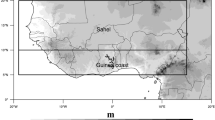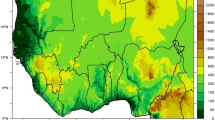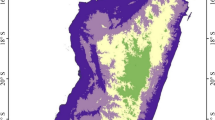Abstract
The ability of the state-of-the-art Global and Regional Climate Models (GCMs and RCMs) to reproduce the mean and spatial characteristics of extreme precipitation indices over Africa is evaluated. In particular, the extent to which CORDEX (COordinated Regional Downscaling Experiment) adds useful details on the performance of CMIP5 (Coupled Model Intercomparison Project Phase 5) multimodel ensemble is investigated. Comparison of the present day simulation was performed with two precipitation observation datasets, the high-resolution TRMM (Tropical Rainfall Measuring Mission) and coarse resolution GPCP (Global Precipitation Climatology Project), to evaluate models strengths and weaknesses. Eight indices generated from absolute (1 mm) and percentile (95th) based thresholds as defined by the Expert Team on Climate Change Detection and Indices (ETCCDI) are computed for seventeen CMIP5 GCMs and six CORDEX RCMs (for twelve downscaling experiments) for each year during the historical period (1975–2004). Our results suggest a good consistency between GPCP and TRMM in producing annual mean and frequency of extreme precipitation events over Africa despite few inconsistencies. However, their associated intensities largely differed from one another with GPCP data displaying drier bias. Overall, multimodel ensembles simulations overestimate the frequency of extreme precipitation events and underestimate their intensities. The results further show that CMIP5 exhibits wet bias of precipitation events and drier bias of precipitation intensity than CORDEX, and that CORDEX produces precipitation magnitude within the range of the observations and more in line with the higher-resolution TRMM data. This illustrates the added value achieved with the higher-resolution CORDEX multimodel ensemble for the simulation of such events, and points toward the use of these RCMs to study extreme precipitation for a better assessment of climate change over Africa.











Similar content being viewed by others
References
Abiodun BJ, Omar SA, Lennard C, Jack C (2015) Using regional climate models to simulate extreme rainfall events in the Western Cape, South Africa. Int J Climatol 36:689–705. https://doi.org/10.1002/joc.4376
Adler RF, Kidd C, Petty G, Morissey M, Goodman HMI (2001) Intercomparison of global precipitation products: the third precipitation Intercomparison project (PIP-3). Bull Am Meteorol Soc 82(7):1377–1396. https://doi.org/10.1175/1520-0477(2001)082<1377:IOGPPT>2.3.CO;2
Blamey RC, Reason CJC (2009) Numerical simulations of a mesoscale convective system over the east coast of South Africa. Tellus 61(1):17–34. https://doi.org/10.1111/j.1600-0870.2008.00366.x
Blamey RC, Reason CJC (2013) The role of mesoscale convective complexes in Southern Africa summer rainfall. J Clim 26:1654–1668. https://doi.org/10.1175/JCLI-D-12-00239.1
Buontempo C, Mathison C, Jones R, Williams K, Wang C, McSweeney C (2014) An ensemble climate projection for Africa. Clim Dyn 44:2097–2118. https://doi.org/10.1007/s00382-014-2286-2
Cretat J, Vizy EK, Cook KH (2013) How well are daily intense rainfall events captured by current climate models over Africa. Clim Dyn (2014) 42:2691–2711. https://doi.org/10.1007/s00382-013-1796-7
Dai A (2006) Precipitation characteristics in eighteen coupled climate models. J Clim 19:4605–4630. https://doi.org/10.1175/JCLI3884.1
Diallo I, Sylla MB, Giorgi F, Gaye AT, Camara M (2012) Multi-model GCM-RCM ensemble based projections of temperature and precipitation over West Africa for the early 21st century. Int J Geophys 2012:972896. https://doi.org/10.1155/2012/972896
Diallo I, Bain CL, Gaye AT, Moufouma-Okia W, Niang C, Dieng MDB, Graham R (2014) Simulation of the West African monsoon onset using the HadGEM3-RA regional climate model. Clim Dyn 43(3):575–594. https://doi.org/10.1007/s00382-014-2219-0
Diedhiou A, Janicot S, Viltard A, De Felice P (1998) Evidence of two regimes of easterly waves over West Africa and tropical Atlantic. Geophys Res Lett 25:2805–2808. https://doi.org/10.1029/98GL02152
Dosio A, Panitz HJ, Schubert-Frisius M, Luethi D (2015) Dynamical downscaling of CMIP5 global circulation models over CORDEX-Africa with COSMO-CLM: evaluation over the present climate and analysis of the added value. Clim Dyn 44(9–10):2637–2661. https://doi.org/10.1007/s00382-014-2262-x
Endri HS, Omondi P, Jain S, Lennard C, Hewitson B, Chang’a L, Awange JL, Dosio A, Ketiem P, Nikulin G, Panitz HJ, Büchner M, Stordal F, Tazalika L (2013) Assessment of the performance of CORDEX regional climate models in simulating East African rainfall. J Clim 26:8453–8475. https://doi.org/10.1175/JCLI-D-12-00708.1
Enyew BD, Steeneveld GJ (2014) Analysing the impact of topography on precipitation and flooding on the Ethiopian Highlands. J Geol Geosci 3:173. https://doi.org/10.4172/2329-6755.1000173
Gbobaniyi EO, Sarr A, Sylla MB, Diallo I, Lennard C, Dosio A, Dhiédiou A, Kamga A, Browne NAK, Hewitson B, Nikulin G, Lamptey B (2014) Climatology, annual cycle and interannual variability of precipitation and temperature in CORDEX regional climate models simulation over West Africa. Int J Climatol 34:2241–2257. https://doi.org/10.1002/joc.3834
Giorgi F, Coppola E (2010) Does the model regional bias affect the projected regional climate change? An analysis of global model projections. Climatic Change 100:787–779. https://doi.org/10.1007/s10584-010-9864-z
Giorgi F, Mearns LO (1999) Introduction to special section: regional climate modeling revisited. J Geophys Res-Atmos 104(6):6335–6352. https://doi.org/10.1029/98JD02072
Giorgi F, Jones C, Asrar G (2009) Addressing climate information needs at the regional level. The CORDEX framework. WMO Bulletin, July 2009 issue
Giorgi F, Coppola E, Raffaele F (2014a) A consistent picture of the hydroclimatic response to global warming from multiple indices: models and observations. J Geophys Res-Atmos 119:11695–11708. https://doi.org/10.1002/2014JD022238
Giorgi F, Coppola E, Raffaele F, Diro GT, Fuentes-Franco R, Giuliani G, Mamgain A, Llopart MP, Mariotti L, Torma C (2014b) Changes in extremes and hydroclimatic regimes in the CREMA ensemble projections. Clim Chang 125:39–51. https://doi.org/10.1007/s10584-014-1117-0
Haensler A, Saeed F, Jacob D (2013) Assessing the robustness of projected precipitation changes over central Africa on the basis of a multitude of global and regional climate projections. Clim Chang 121:349–363. https://doi.org/10.1007/s10584-013-0863-8
Hart NCG, Reason CJC, Fauchereau N (2010) Tropical-extratropical interactions over southern Africa: these cases of heavy summer season rainfall. Mon Weather Rev 138:2608–2623. https://doi.org/10.1175/2010MWR3070.1
Huffman GJ, Bolvin DT, Nelkin EJ, Wolff DB, Adler RF, Gu G, Hong Y, Bowman KP, Stocker EF (2007) The TRMM multisatellite precipitation analysis (TMPA): quasi-global, multiyear, combined-sensor precipitation estimates at fine scales. J Hydrometeorol 8:38–55. https://doi.org/10.1175/JHM560.1
Huffman GJ, Adler RF, Bolvin DT, Gu G (2009) Improving the global precipitation record: GPCP version 2.1. Geophys Res Lett 36:L17808. https://doi.org/10.1029/2009GL040000
IPCC (2012) Managing the risks of extreme events and disasters to advance climate change adaptation. A Special Report of Working Groups I and II of the Intergovernmental Panel on Climate Change. Cambridge University Press, Cambridge 582 pp
IPCC (2013) Climate change 2013: the physical science basis. Contribution of Working Group I to the Fifth Assessment Report of the Intergovernmental Panel on Climate Change. In: Stocker TF, Qin D, Plattner GK, Tignor M, Allen SK, Boschung J, Nauels A, Xia Y, Bex V, Midgley PM (eds) . Cambridge University Press, Cambridge 1535 pp
Jones C, Giorgi F, Asrar G (2011) The Coordinated regional downscaling experiment: CORDEX an international downscaling link to CMIP5. Clivar Exchanges 16:34–40
Kalognomou EA, Lennard C, Shongwe M, Pinto I, Favre A, Kent M, Hewitson B, Dosio A, Nikulin G, Panitz HJ, Büchner M (2013) A diagnostic evaluation of precipitation in CORDEX models over Southern Africa. J Clim 26:9477–9506. https://doi.org/10.1175/JCLI-D-12-00703.1
Karl T, Easterling D (1999) Climate extremes: selected review and future research directions. Clim Chang 42(1):309–325. https://doi.org/10.1023/A:1005436904097
Kim J, Waliser DE, Mattmann CA, Goodale CE, Zimdars AF, Crichton DJ, Jones C, Nikulin G, Hewitson B, Jack C, Lennard C, Favre A (2013) Evaluation of the CORDEX-Africa multi-RCM hindcast: systematic model errors. Clim Dyn 42(5–6):1189–1202. https://doi.org/10.1007/s00382-013-1751-7
Klein Tank AMG, Zwiers FW, Zhang X (2009) Guidelines on analysis of extremes in a changing climate in support of informed decisions for adaptation, Climate data and monitoring. WCDMP-No. 72, 56 pp
Klutse NAB, Sylla MB, Diallo I, Sarr A, Dosio A, Diedhiou A, Kamga A, Lamptey B, Ali A, Gbobaniyi EO, Owusu K, Lennard C, Hewitson B, Nikulin G, Panitz HJ, Büchner M (2015) Daily characteristics of West African monsoon rainfall in CORDEX regional climate models. Theor Appl Climatol 05(02):63. https://doi.org/10.1007/s00704-014-1352-3
Knippertz P, Martin JE (2005) Tropical plumes and extreme precipitation in subtropical and tropical West Africa. Q J R Meteorol Soc 131(610):2337–2365. https://doi.org/10.1256/qj.04.148
Laprise R, Hernández-Díaz L, Tete K (2013) Climate projections over CORDEX Africa domain using the fifth-generation Canadian Regional Climate Model (CRCM5). Clim Dyn 41(11):3219–3246. https://doi.org/10.1007/s00382-012-1651-2
Lee JE, Pierrehumbert R, Swann A, Linter BR (2009) Sensitivity of stable water isotopic values to convective parameterization schemes. Geophys Res Lett 36:L23801. https://doi.org/10.1029/2009GL040880
Li F, Collins WD, Wehne MF, Williamson DL, Olson JG (2011a) Response of precipitation extremes to global warming in an aqua-planet climate model: towards robust projections from regional to global scales. Tellus 63(5):876–883. https://doi.org/10.1111/j.1600-0870.2011.00543.x
Li F, Collins WD, Wehner MF, Williamson DL, Olson JG, Algieri C (2011b) Impact of horizontal resolution on simulations of precipitation extremes in an aqua-planet version of the Community Atmospheric Model (CAM). Tellus 63(5):884–892. https://doi.org/10.1111/j.1600-0870.2011.00544.x
Mariotti L, Diallo I, Coppola E, Giorgi F (2014) Seasonal and intraseasonal changes of African monsoon climates in 21st century CORDEX projections. Clim Chang 125:53–65. https://doi.org/10.1007/s10584-014-1097-0
Mounkaila MS, Abiodun BJ, Omotosho JB (2015) Assessing the capability of CORDEX models in simulating onset of rainfall in West Africa. Theor Appl Climatol 119:255–272. https://doi.org/10.1007/s00704-014-11404-4
Nikulin G, Jones C, Giorgi F, Asrar G, Büchner M, Cerezo-Mota R, Christensen OB, Déqué M, Fernandez J, Hänsler A, van Meijgaard E, Samuelsson P, Sylla MB, Sushama L (2012) Precipitation climatology in an ensemble of CORDEX-Africa regional climate simulations. J Clim 25:6057–6078. https://doi.org/10.1175/JCLI-D-11-00375.1
Shongwe ME, Van Oldenborgh GJ, Van den Hurk BJJM, de Boer B, Coelho CAS, Van Aalst MK (2009) Projected change in mean and extreme precipitation in Africa under global warming. Part I: southern Africa. J Clim 22:3819–3837. https://doi.org/10.1175/2009JCLI2317.1
Sillmann J, Kharin VV, Zhang X, Zwiers FW, Bronaugh D (2013a) Climate extremes indices in the CMIP5 multimodel ensemble: part 1. Model evaluation in the present climate. J Geophys Res-Atmos 118:1716–1733. https://doi.org/10.1002/jgrd.50203
Sillmann J, Kharin VV, Zwiers FW, Zhang X, Bronaugh D (2013b) Climate extremes indices in the CMIP5 multimodel ensemble: part 2. Future climate projections. J Geophys Res Atmos 118:2473–2493. https://doi.org/10.1002/jgrd.50188
Stephens GL, L’Ecuyer T, Forbes R, Gettlemen A, Golaz JC, Bodas-Salcedo A, Suzuki K, Gabriel P, Haynes J (2010) Dreary state of precipitation in global models. J Geophys Res-Atmos 115:D24211. https://doi.org/10.1029/2010jd014532
Sylla MB, Gaye AT, Jenkins GS (2012) On the fine-scale topography regulating changes in atmospheric hydrological cycle and extreme rainfall over West Africa in a Regional Climate Model projections. International Journal of Geophysics 2012:981649. https://doi.org/10.1155/2012/981649
Sylla MB, Giorgi F, Coppola E, Mariotti L (2013a) Uncertainties in daily rainfall over Africa: assessment of observation products and evaluation of a regional climate model simulation. Int J Climatol 33:1805–1817. https://doi.org/10.1002/joc.3551
Sylla MB, Diallo I, Pal JS (2013b) West african monsoon in state-of-the-science regional climate models, Climate Variability - Regional and Thematic Patterns. Tarhule A (ed). ISBN: 978–953–51-1187-0, InTech. https://doi.org/10.5772/55140
Sylla MB, Elguindi N, Giorgi F, Wisser D (2015a) Projected robust shift in climatic zones over West Africa in response to anthropogenic climate change for the late 21st century. Clim Chang:1–13. https://doi.org/10.1007/s10584-015-1522-z)
Sylla MB, Giorgi F, Pal JS, Gibba P, Kebe I, Nikiema M (2015b) Projected changes in the annual cycle of high intensity precipitation events over West Africa for the late 21st century. J Clim 28:6475–6488. https://doi.org/10.1175/JCLI-D-14-00854.1
Taylor KE (2001) Summarizing multiple aspects of model performance in a single diagram. J Geophys Res-Atmos 106(D7):7183–7192
Taylor KE, Stouffer RJ, Meehl GA (2012) An overview of CMIP5 and the experiment design. Bull Am Meteorol Soc 93:485–498. https://doi.org/10.1175/BAMS-D-11-00094.1
Tebaldi C, Knutti R (2007) The use of the multi-model ensemble in probabilistic climate projections. Philos Trans A Math Phys Eng Sci 365:2053–2075. https://doi.org/10.1098/rsta.2007.2076
Vizy KE, Cook KH (2012) Mid-twenty-first-century changes in extreme events over Northern and Tropical Africa. J Clim 25:5748–5767. https://doi.org/10.1175/JCLI-D-11-00693.1
Zhang X, Alexander L, Hegerl GC, Jones P, Tank AK, Peterson TC, Trewin B, Zwiers FW (2011) Indices for monitoring changes in extremes based on daily temperature and precipitation data. WIREs Clim Change 2:851–870. https://doi.org/10.1002/wcc.147
Acknowledgements
This work is supported by the German Federal Ministry of Education and Research through the West African Science Service Center on Climate Change and Adapted Landuse (WASCAL). We wish to thank the CMIP5 and CORDEX modeling centers for sharing the datasets used in this study and also the reviewers for their valuable comments.
Author information
Authors and Affiliations
Corresponding author
Electronic supplementary material
ESM 1
(PDF 21391 kb)
Rights and permissions
About this article
Cite this article
Gibba, P., Sylla, M.B., Okogbue, E.C. et al. State-of-the-art climate modeling of extreme precipitation over Africa: analysis of CORDEX added-value over CMIP5. Theor Appl Climatol 137, 1041–1057 (2019). https://doi.org/10.1007/s00704-018-2650-y
Received:
Accepted:
Published:
Issue Date:
DOI: https://doi.org/10.1007/s00704-018-2650-y




